The post Kids and Divorce: Security & Continuity Count appeared first on Nancy Wesson Consulting.
]]>Resilience
One of the most worrisome aspects of divorce is helping our children thrive as they navigate their new future. Some comfort might be taken from what a children’s therapist once told me: “ Kids are amazingly resilient and will take their queue from the parent’s attitude about the divorce. If {the custodial parent} is OK – the kids will be O.K.”
Intention in Practical Terms
In Feng Shui, our desire to move forward and help our children do the same, would be called intention. In other words, it’s our conscious commitment to creating the life we choose, expressed in our attitude, decisions and actions. In practice, living with intention means living proactively, not reactively. So—although the family dynamic has changed, each parent still has the opportunity to build new memories and history with their children.
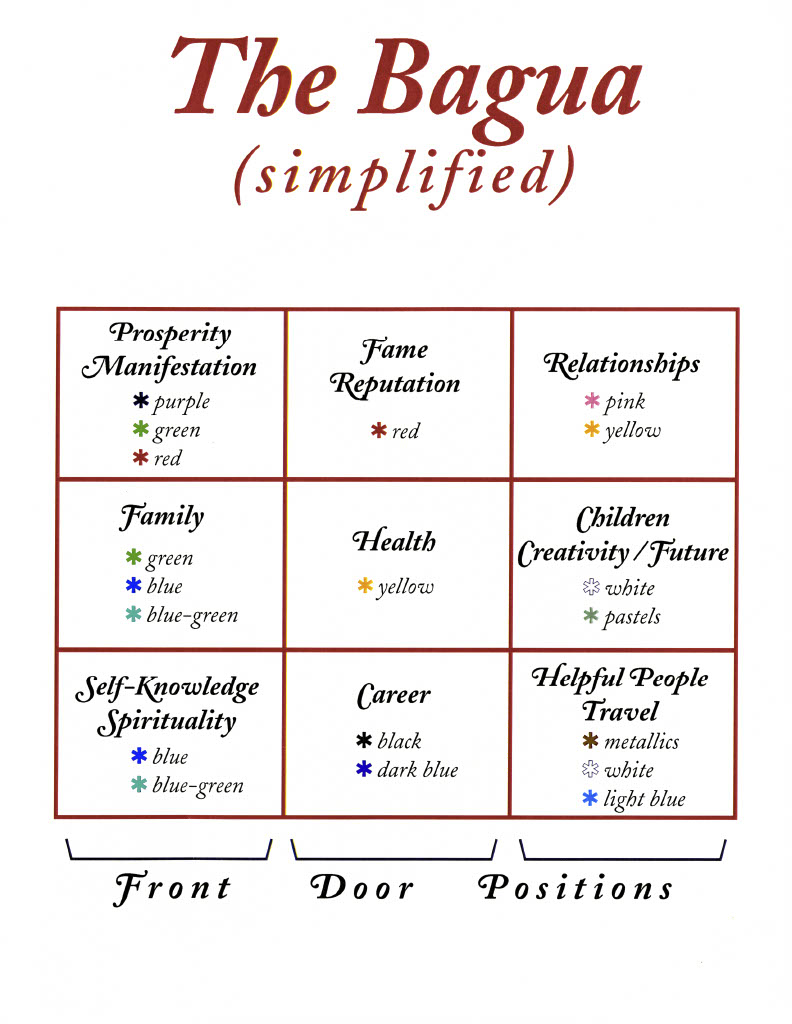
(In the Feng Shui Bagua, Children, Creativity and Future share a section, because Children represent our desire to create brought into the future.)
Seize this opportunity to discover what your kids are looking forward to. While you’e at it, ask yourself the same question. Don’t assume that just because your family has “always done” certain things that you need to stay in lock-step. Use this new information to empower your vision of the future as a family and as individuals.
Fun project: make a vision board of you all would like to do/see as part of life going forward. Then place the finished product in the future-area of either the house or of a room. (The door of entry becomes the front door (symbolically) so the future wall in the middle of the wall to the right upon entering.)
Feeling Secure Tops the List
While having fun is important, establishing healthy routines, maintaining contacts with friends and family members, and keeping a sense of humor all foster a sense of security. I’m not a therapist, but I know that when kids feel secure, they can relax. When that happens, fun can then emerge in the most ordinary activities—it need not be an event.
The post Kids and Divorce: Security & Continuity Count appeared first on Nancy Wesson Consulting.
]]>The post The Magic of the Bagua to Create Balance appeared first on Nancy Wesson Consulting.
]]>Reclaimed and updated from Divorce360 February 2008
I’m newly divorced and trying to choose a house based on the Feng Shui model, but am confused about the Feng Shui map. I want to create a sense of balance in my new life and I hear that the choice of a floor plan can make a difference.
Put Your Floor Plan to Good Use
You’re correct. Feng Shui is based on the understanding that our home environment influences the way life unfolds. The layout of a house matters partially because it relates to the efficiency and flow of the space. It’s also important for all of the nine Feng Shui life domains to be represented in the floor plan, though corrections can be made.
All of that said, if you find a place that feels good and that you love, you can change the balance and flow of the physical space through the use of Feng Shui adjustments. Those include furniture arrangement, ergonomics, symbolism, color, and light – to list a few.
Staying Centered
In addition, life feels more centered and is less likely to be derailed when there is balance among these aspects. A square or rectangular floor plan is ideal because all nine life areas are represented. In western schools of Feng Shui, the map (Bagua) is oriented to the architectural front door, not compass direction. If the shape of the house is a square or rectangle the map would look like the map below. Just remember, the areas are energetic, not defined by interior wall placement.

When speaking of floor plan, you’re concerned with the actual footprint of the house and what falls under the roofline of the property. (And yes—the garage counts, to answer a question I am frequently asked.) If one or more of these areas is missing, it can influence not only the way the house feels, but also the way life flows. If you know this going in, you can make the adjustments before moving in and pre-empt issues.
TIP: Position the bottom of the Map with the front-most wall of the house on a line that is parallel to that of the front door. If the front door is set back from leading wall of the house, the bottom of the map lines-up with the front edge, not the door.
Reclaiming Missing Areas
Missing areas can be reclaimed using both literal and symbolic adjustments. Just as a plant sends out an energetic template into which a leaf grows, the layout of a house seems to act as a template into which life unfolds. It’s important to know that the symbolic corrections made are as effective as architectural ones. It’s all about energy.
How Do YOU FEEL Standing in the House?
Some of the most interesting houses, have floor plans that don’t conform to the map, so that shouldn’t be your overarching concern. The external environment is equally important. What do you see when you look out the windows and front door? What are your other senses telling you? Is it lined up with a T-intersection? Such houses are heavily impacted by the energy moving down the street directly at the house.
Do your due-diligence on the house (inspections, etc.), but otherwise: Does the house FEEL good and does it have the potential for adjustments?
The post The Magic of the Bagua to Create Balance appeared first on Nancy Wesson Consulting.
]]>The post Planning for the Future appeared first on Nancy Wesson Consulting.
]]>Reprinted from The Austin Homesteader, 2003
I wish I may, I wish I might – have the wish I wish tonight…..
Interesting, don’t you think, that old expression “Be careful what you wish for, you might just get it.” On one hand we are taught as children that wishing is a fantasy. Fairy Tales tell us that “wishes really do come true.” We are told both “You create you own reality,” and “Wishing doesn’t make it so.” So what’s true in this mix? Well, if it were one of those trick multiple choice questions our college teachers, the SAT, GRE and all the others love so much – I would have to choose “All of the above.” But with some explanation.
Passion vs. Fear
In previous articles, I’ve introduced the idea that we certainly have a hand in creating our present and future reality. Also, that positive thinking alone won’t do it – you have to passionate about the desire. Being passionate in either direction will do it – fear pulls in stuff, just as joy does. So I would modify the “Be careful what you wish for – by saying, “Be careful where you spend your emotional time, you might just pull in more of the same.”
If a person can embrace that concept, the next question is usually, “But how do you stay out of the negative and move toward something more positive. Or how do you keep your goal in mind and support it with the excitement of reaching it (rather than the fear of NOT reaching it)? There are some good tricks available from – yep – Feng Shui.
Psychological-Feedback Loop
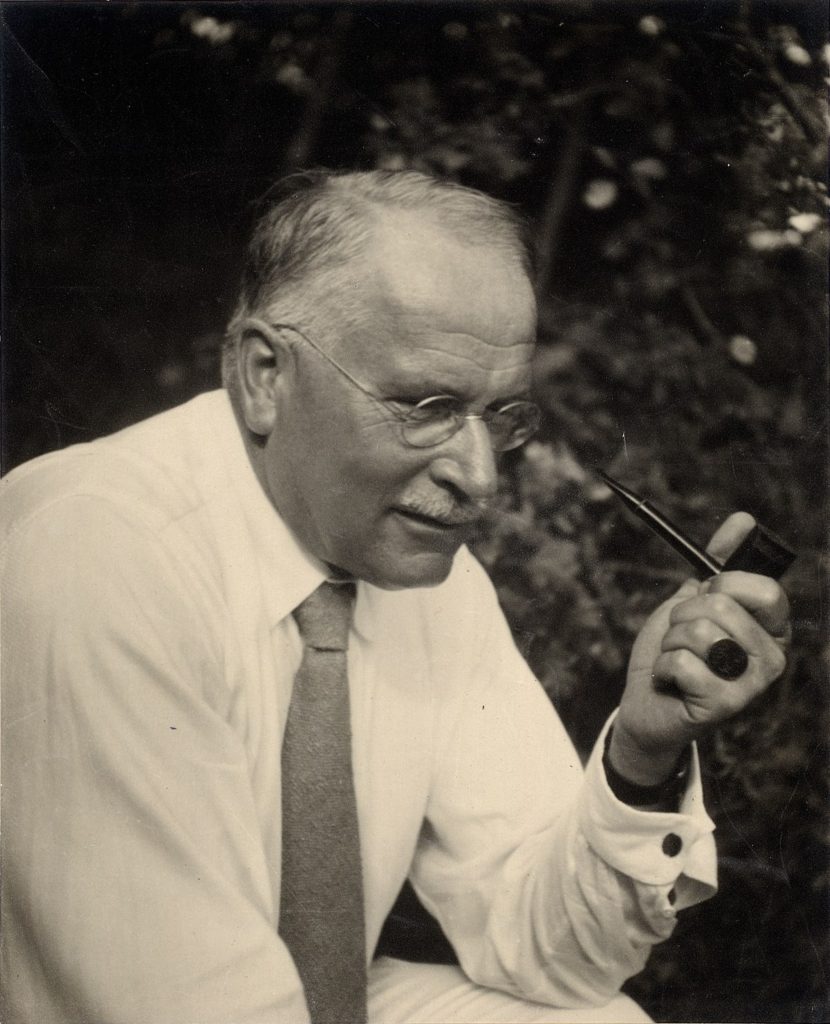
Most people think of Feng Shui as the art of arranging furniture to be able to create an inviting space… and that’s true. BUT, and it’s a big “but,” – it’s far more than that. Feng Shui is a method of getting clear about what you want in your life, then creating an ergonomically sound environment, rich in the symbolism that keeps you constantly reminded of where you want to be and go. It supports you in your goals, by keeping them at the forefront of your physical, mental, and spiritual worlds. Carl Jung (left), the famous Swiss psychiatrist (1875-1961) called this a psychological feedback loop.
There is a sector in the Feng Shui map or Bagua that relates to the Future, although on most Baguas you will see it defined as Children or Creativity. Understanding that Children represent physical Creativity brought into the Future, helps make sense of the fact that the Future sector is also is associated with bringing projects and desires into the future.
Look Right!

The position of that sector is 45 degrees to the RIGHT of the primary point of entry into a room or a house (via the architectural front door). Put another way, if the entry is in the middle of the wall, (see Front Door Positions in the Bagua image to the right) then the Future Gua falls at the 3:00 position. We know, through the science of Merchandizing, that merchandize placed in that position in the room will sell faster and for the highest price. Pretty interesting that both a 5,000 year old esoteric philosophy and a statistically based science like merchandizing agree on that position being a very powerful one.
News You Can Use
So here’s some news you can use:
- Choose a specific “heart’s desire”
- Find a symbolic representation of that desire ( i.e. a picture, sculpture, phrase, etc)
- Place the symbol in the Future area
- While placing it, state your intention about the desire
- Be observant for subtle changes, interactions, etc that relate to the goal
Superstition: Not really
Some folks wonder if this isn’t just a little superstitious. Well, merchandizing is not based on superstition; if something sells – it sells. The action at work in Feng Shui (a science of observation) is that of looking obliquely-right when we enter a room. Check it out for your self. Every time we walk through the door, we unconsciously notice whatever is displayed on the right. We may even lose conscious awareness of it, but it imprints on the brain just the same. What we are constantly reminded of becomes part of the subconscious – reminding us of our aspirations. Conversely, if you have objects around you that have a negative connotation, you begin to think and feel negatively – placing limits on yourself.
The Power Position
Here are a couple of real life examples. You can interpret these facts however you like, but the “coincidences” are interesting. The first has to do with a client whose home I helped organize. Nearly every room needed work, both in clutter busting and arrangement.
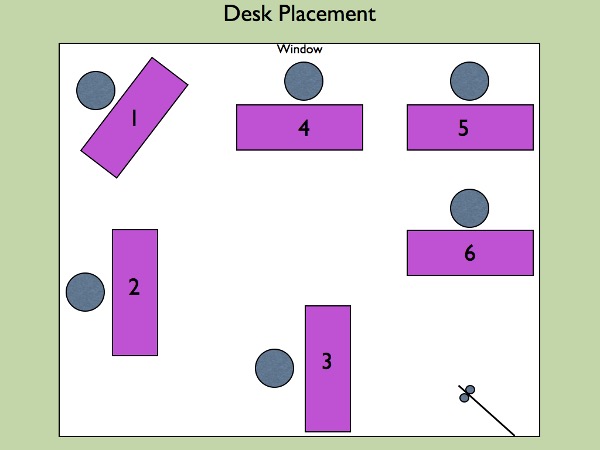
Her husband’s office started with him working with his face to the wall and back to the door. We moved the desk to its most commanding position, known as the power position, and got it organized. In the process we found a picture of a diner in San Francisco (city changed to protect privacy). We hung it in the Future area, because that’s where it worked. There was no current plan or desire to relocate there.
(Note: Position #1 to the left is the power position. Image: from my book, Moving Your Aging Parents)
A week or so later, the husband, who had never requested a transfer and whose job was secure, got a promotion which required him to move to San Francisco. They sold their house and moved within a month.
Subliminal Reminders
Another story involves one of my sons (now 20) who received a large poster made by combining two smaller posters of his favorite things: fast cars and a dense redwood forest with a mountain stream and a bridge leading to a small cabin. This poster – with the title “The Motivation for Higher Education” looked like a clever underground garage housing five super fast sports cars – under the canopy of the redwoods. I’d hung over his desk, where he could see it from his bed and – when he entered his room. And yes – it remained there, in the Future position, for about 6 months and I replaced it with maps.
Choosing an alternative to college, we had reserved him a spot in a fantastic, month long intensive experiential home building course in Vermont or some such place. The week before he was to leave, he broke his heel bone. Not only is this bone nearly impossible to break, it’s nearly as stubborn to heal. He had to be off his feet – no crutches for this break – for 6 weeks, eliminating any possibility of his going to Vermont. He was morose. One night, he stayed up surfing the Web – not usual for him.
The Realization
The next morning he announced his new passion was racing cars. The only school with a racing program that would also teach him a “practical skill” was Jim Russell Racing School at Sears Point Race Way in Napa Valley – northern California – home of great wine and giant redwoods. It wasn’t until we were cleaning out his closet, getting him ready to leave that I re-discovered the poster in his closet. That’s when it hit me – and it still gives me a little chill when I realize the connection.

The little cabin by the stream was waiting there too and up for rent, though we decided on something less primitive. Although he was a normal teenage boy, with fantasies of having the fastest car on the planet, racing had never been in his vernacular as a career. But we won’t go there… Now he’s flying helicopters in Oregon and I WANT TO KNOW WHO GAVE HIM A PICTURE OF HELICOPTERS!!!!!
Do with this, as you will. It’s another example of how the objects in our surroundings impact us and more importantly how we can consciously use artwork and accessories to create a path for ourselves.
As always, I welcome your calls, questions or stories. Let me hear from you at [email protected]
The post Planning for the Future appeared first on Nancy Wesson Consulting.
]]>The post Feng Shui Your Garden appeared first on Nancy Wesson Consulting.
]]>Reprinted from The Austin Homesteader, 2001
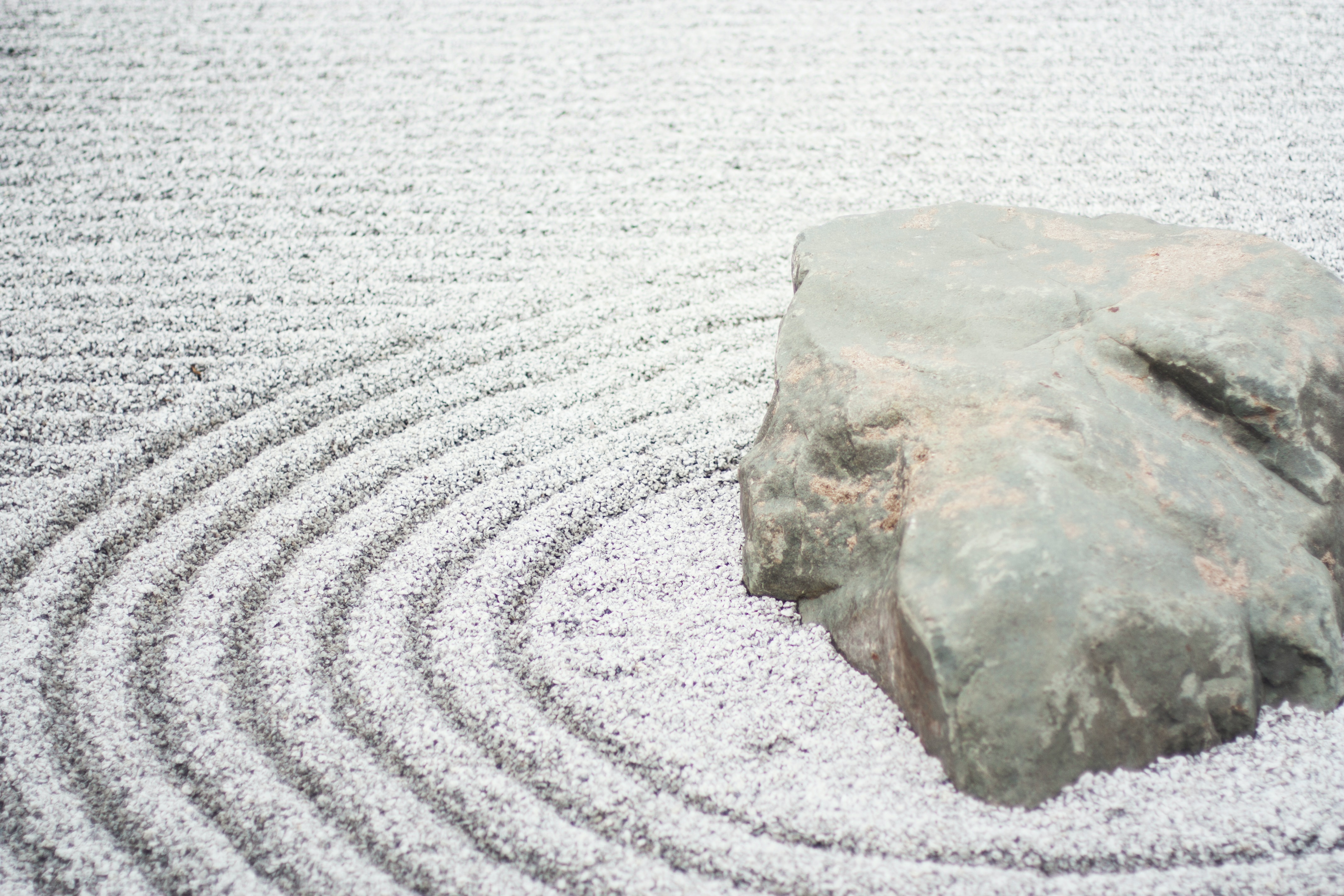
The image to the left is a ZEN Garden, NOT a Feng Shui Garden.
When folks ask me about Feng Shui and gardening, there seems to be some confusion about them being Zen gardens. The two couldn’t be more different. A Zen garden is very – well Zen! When I think of a Zen garden – it’s sparse with open space and lots of sand or rock with a few larger rocks. Designed for clearing the mind of everything extraneous, visual stimulation is at a minimum. Beautiful and serene with little to stimulate the senses.
Feng Shui Gardens are Not Zen
However, the image below IS a Feng Shui Garden. Feng Shui gardens, on the other hand meander – with winding trails, plants, rocks, statuary if you like, benches – always a little gift around every bend. There are little pockets of refuge and privacy mixed with vistas – all brought together in a balanced elemental flow. In five-element terms it means you have Water, Wood, Fire, Earth and Metal represented in ways that strike your fancy and honor the natural habitat.
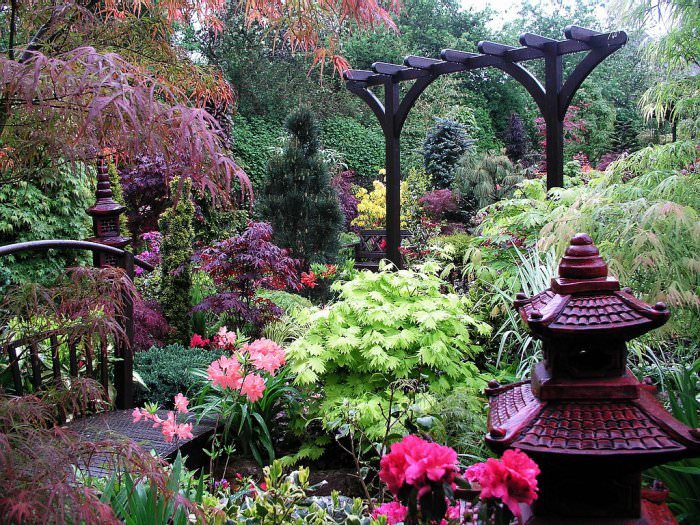
Notice the variation in color and texture of the plants; the presence and placement of various sculptures and objects of art – even an arch. There are varying heights to let the eyes play. Chances are, walking through this garden would offer more surprises, maybe a bench or an even a meditation spot. In all likelihood there’s a fountain or a pond tucked in somewhere as well. It tickles the senses.
Orienting Your Garden

When you’re orienting your garden, remember that the garden Bagua can start in the front yard and include the entire property or start at the back door and include only the back yard. You can start your garden anywhere on the property and pick an entry point, which functions as the “front door” to your garden. I really would not get too hung up on that. People tend to get a little anxious about the specifics and that is completely contrary to the point of a Feng Shui space. For me, the most important aspects are balance and the use of symbolism, to create a space that embraces you with a mix of life, movement, sound, fragrance, color, and texture. All of this should be consistent with the environment in which you are creating the garden.
So – if you’re in Phoenix, trying to create a garden using tropical plants that need frequent irrigation – necessitating constant care or an additionally installed watering system – is not Feng Shui. Similarly, if you’re in Louisiana and trying to do Xeroscape – with plants that need little or no water – well good luck! Honor the territory you happen to be in.
But Can I Use Cacti?
A lot has been made in Feng Shui about the use of cacti and sharp, pointed sword like plants. They are typically considered rather relationship hostile and non- welcoming for obvious reasons. But if you live in an arid climate, you use plants that are in harmony with that place – and sometimes that’s cactus. Just use a little common sense. Another place to use a liberal dose of common sense is the use of color.
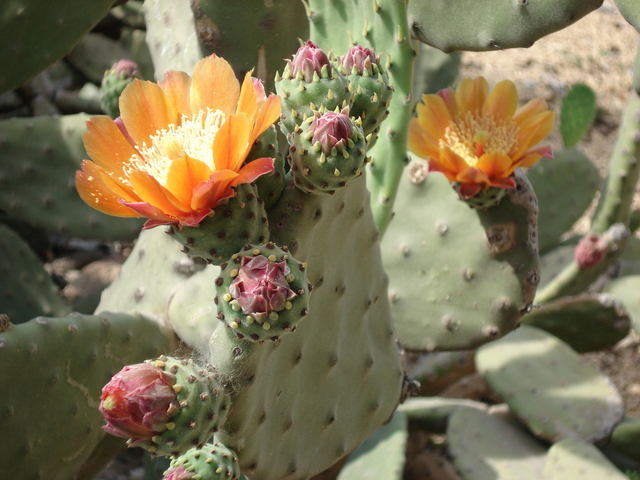
Any of you who know about Feng Shui are aware that each of the elements has a series of colors associated with it. In this context people are always asking, do I need red flowers here, blue flowers there? Here’s the deal – you first have to consider the issues you would look at in ANY healthy garden. Think about the elements of sun, water, wind, shade, soil conditions, etc and first choose plants that will thrive (or at least tolerate) the present conditions. Then look at texture, shape of the plant, size and shape of the leaf, and finally color. Your life will be so much easier and your gardening experience will be more pleasurable.
Any of you who know about Feng Shui are aware that each of the elements has a series of colors associated with it. In this context people are always asking, do I need red flowers here, blue flowers there? Here’s the deal – you first have to consider the issues you would look at in ANY healthy garden. Think about the elements of sun, water, wind, shade, soil conditions, etc and first choose plants that will thrive (or at least tolerate) the present conditions. Then look at texture, shape of the plant, size and shape of the leaf, and finally color. Your life will be so much easier and your gardening experience will be more pleasurable.
Using the Five Elements
Here are a few suggestions to help you make choices that relate to the five elements (water, wood, fire, earth, metal). Remember that these can come in the form of vegetation, sound, color, texture or garden accessories including rock formations, sculptures, water features, path ways, etc.
The variations are endless. Items can also be more than one element at a time. Choose the most predominant aspect and have fun! This is a time to engage ALL of your senses!
- Water: water itself, water features, broad leaf floppy or draping plants, shady/cool areas, amorphous shapes. Ponds should have a way for critters like frogs to climb out after they hopped in. Drowned frogs are not good Feng Shui.

- Wood: all living plants fall into the wood category. That said, wood shapes are more columnar or cylindrical, upright and tree like. Color is also an aspect, and the color for wood is green, not brown.
- Fire: sharp pointy leaf plants, the color red, sculptures that are angular or pointy, suns, brightly glazed tiles, shiny or bright colors. Any fanciful whimsical art work or mobiles, plastic planters also qualify as fire. Fire is FUN!
- Earth: flowers, terra cotta pots, heavy objects or sculptures, Mexican-clay tile, earth-colors, square/blocky shapes, soft comfy cushions, boulders, etc. Herbs or plants that are fragranced when you brush against them (mint, thyme, santolina, etc) earthen ware planters also qualify.
- Metal: plants that are rounded or globe like in shape. Obviously metal itself, or smooth surface sculptures, elegant fixtures, soft pastel colors, the sound of metal clinking.
Benches
Let’s talk about benches or meditation areas. Any area where you sit should have some feeling of protection behind it, so you feel comfortable and secure. Remember the concept of arm-chair shape – with support all around you – looking forward into a more open space. This can be accomplished with a hedge, a tree, wood lattice privacy screen or a stone wall. Paths, edging and outlines of beds should be curved and feel natural or meandering. Ever notice there are no straight lines in nature? Follow that lead.
Keep it Curvy!
In Hong Kong, even the straightest walkway is designed to look curved through the use of brick layout, plantings or shadows falling across the walk. Let your creativity soar, your fantasy life come alive! Feng Shui begs you to use ALL of your senses to celebrate life and create beauty with what you have on hand.
The post Feng Shui Your Garden appeared first on Nancy Wesson Consulting.
]]>